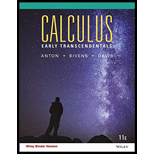
Use the Divergence Theorem to find the flux of F across the surface
Want to see the full answer?
Check out a sample textbook solution
Chapter 15 Solutions
CALCULUS EARLY TRANSCENDENTALS W/ WILE
Additional Math Textbook Solutions
Calculus & Its Applications (14th Edition)
Calculus: Single And Multivariable
Calculus 2012 Student Edition (by Finney/Demana/Waits/Kennedy)
Calculus: Early Transcendentals (3rd Edition)
Precalculus (10th Edition)
Precalculus Enhanced with Graphing Utilities (7th Edition)
- Use the Divergence Theorem to find the flux of F(x, y, z)=z³ i-x³j+y³ k across the sphere x² + y² + z² = a² with outward orientation. $ = iarrow_forwardII. Let S be the portion of the cylinder x² - 6x + z = 4, oriented by upward-slanting normal vectors, that is cut by the planes y = 1, y = 4, and z = 0. Find the flux of F(x, y, z) = (xy, 3xz², yz) across S.arrow_forwardFind the flux of F= (y, z-y, z) across the tetrahedron with vertices (0,0,0), (1,0,0), (0, 1,0), (0,0,1) and has the outward orientation.arrow_forward
- Let F(x, y, z)=(v)i+(x)j+(z²)k. Find the flux of F across the positively oriented closed surface S where S is the surface of the sphere x + y +z² = 4.arrow_forwardLet F = -9zi+ (xe#z– 2xe**)}+ 12 k. Find f, F·dĀ, and let S be the portion of the plane 2x + 3z = 6 that lies in the first octant such that 0 < y< 4 (see figure to the right), oriented upward. Z Explain why the formula F · A cannot be used to find the flux of F through the surface S. Please be specific and use a complete sentence.arrow_forwardConsider the space curve represented by the intersection of the surfaces. Represent the curve by a vector-valued function r(t) using the given parameter. r(t) = Surfaces z = x² + 2y², x+y=0 Parameter x = tarrow_forward
- Find the points on the plane r- y = 2 – z closest to the point (1, 1, 1).arrow_forwardFind the point on the plane x – 3 y – 2 z = 14 that is closest to the point (0, 3, 3) .arrow_forwardLet F = (z, 0, y) and let S be the oriented surface parametrized by Þ(u, v) = (u² – v, u, v²) for 0 ≤ u ≤ 3, −1 ≤ v ≤ 4. (a) Calculate N and F. N as functions of u and v. (Use symbolic notation and fractions where needed.) N = (2v,-4uv,1) F.N= (b) Calculate the normal component of F to the surface at P = (6,3,9) = Þ(3, 3). (Use symbolic notation and fractions where needed.) normal component at P = Incorrect 2v³+u IF (c) Calculate F. ds. (Give your answer as a whole number.) F.dS= 63 1333 Incorrectarrow_forward
- Use Divergence theorem to find the outward flux of F = (7x², e¹², cos³x² + x)) OS of the cube in R³ bounded by the planes x = 0, x = 2, y = 0, y = 2, z = 0, z = 2.arrow_forwardAssume that the second partial derivatives of the surface X = x(0, 4) are given by Xo4 = 0, X4 - e, + 2pes X00 = 0e, – 2pe,, And has the unit normal vector N = sin0e, + cos o ez. Then the second fundamental form coefficients L, M, and N of the surface are given by L-O sin -2o cos . M-0,N- sin ở + 20 cos o L = 0 sin 0, M = 0, N = sin 0 The above answer The above a nswer L= 0 sin 0, M = 0, N - 20 cos o I. - O sin 0. M- 0. N- sin 0 + 20 cos o The a bove ans wer The above a ns werarrow_forward4. Consider the vector function r(z, y) (r, y, r2 +2y"). (a) Re-write this vector function as surface function in the form f(1,y). (b) Describe and draw the shape of the surface function using contour lines and algebraic analysis as needed. Explain the contour shapes in all three orthogonal directions and explain and label all intercepts as needed. (c) Consider the contour of the surface function on the plane z= for this contour in vector form. 0. Write the general equationarrow_forward
 Calculus: Early TranscendentalsCalculusISBN:9781285741550Author:James StewartPublisher:Cengage Learning
Calculus: Early TranscendentalsCalculusISBN:9781285741550Author:James StewartPublisher:Cengage Learning Thomas' Calculus (14th Edition)CalculusISBN:9780134438986Author:Joel R. Hass, Christopher E. Heil, Maurice D. WeirPublisher:PEARSON
Thomas' Calculus (14th Edition)CalculusISBN:9780134438986Author:Joel R. Hass, Christopher E. Heil, Maurice D. WeirPublisher:PEARSON Calculus: Early Transcendentals (3rd Edition)CalculusISBN:9780134763644Author:William L. Briggs, Lyle Cochran, Bernard Gillett, Eric SchulzPublisher:PEARSON
Calculus: Early Transcendentals (3rd Edition)CalculusISBN:9780134763644Author:William L. Briggs, Lyle Cochran, Bernard Gillett, Eric SchulzPublisher:PEARSON Calculus: Early TranscendentalsCalculusISBN:9781319050740Author:Jon Rogawski, Colin Adams, Robert FranzosaPublisher:W. H. Freeman
Calculus: Early TranscendentalsCalculusISBN:9781319050740Author:Jon Rogawski, Colin Adams, Robert FranzosaPublisher:W. H. Freeman
 Calculus: Early Transcendental FunctionsCalculusISBN:9781337552516Author:Ron Larson, Bruce H. EdwardsPublisher:Cengage Learning
Calculus: Early Transcendental FunctionsCalculusISBN:9781337552516Author:Ron Larson, Bruce H. EdwardsPublisher:Cengage Learning





